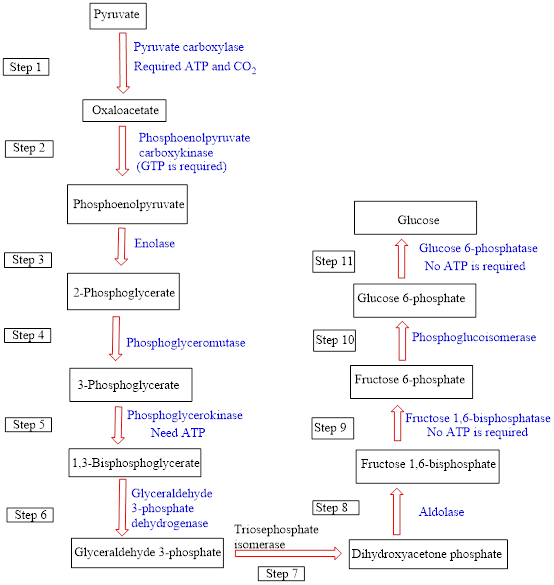
Concept explainers
(a)
Interpretation: To identify the step in gluconeogenesis that involves the conversion of a
Concept introduction: Gluconeogenesis is an eleven-step pathway in which glucose is produced from non-carbohydrate substances. An overview of gluconeogenesis is as follows:

A
(b)
Interpretation: To identify the step in gluconeogenesis that involves
Concept introduction: Gluconeogenesis is an eleven-step pathway in which glucose is produced from non-carbohydrate substances. An overview of gluconeogenesis is as follows:

A reactant is defined as the substance that is initially present in the chemical reaction and gets consumed to form a new substance.
Want to see the full answer?
Check out a sample textbook solution
Chapter 24 Solutions
EBK GENERAL, ORGANIC, AND BIOLOGICAL CH
- The cholesterol synthesized by cells uses which component of the glycolytic pathway as a starting point? a. glucose b. acetyl CoA c. pyruvate d. carbon dioxidearrow_forwardA hydrophilic drug A.Has a high reabsorption in renal tubules B.Has a low ability to penetraye the cell membrane C.Can cross the blood brain barrier easily D.Can bind to intracellular receptors. 2.The phase 1 reaction most often performed by mixed function CYP450 hepatic microsomal enzyme is A.Glucuronidation B.Oxidation C.Reduction D.Acetylation 3.CYP1A2 is involved in the metabolizing of several clinically important xenobiotics such as A.Caffeine B.Morphine C.Aspirin D.Alcohol 4.Drug metabolism,the drug.......undergoes phase 2(acetylation)before undergoing phase 1 (hydrolysis) metabolic reactions A Aspirin B.Codeine C.Isoniazid D.Diazepam E.Phenytoin 5.Which of the following statements is/are true regarding the oxidation of aromatic rings A.Electron donating substituents promote oxidationat the meta position B.Electron withdrawing substituents promote oxidation at the meta position C.All aromatic rings in a molecule are hydroxylated D Monosubstituted aromatic rings can be…arrow_forwardThe following enzymes belong to the same class of enzymes, except for A. Chymotrypsin B. Thrombin C. Lysozyme D. Alcohol dehydrogenase E. Elastasearrow_forward
- Which of the following molecules are not involved in lipolysis within adipocytes? a. protein kinase A b. PEPCK c. adenylate cyclase d. perilipin-1arrow_forwardWhich of the following is incorrect about the chymotrypsin mechanism? a. When His removes a proton from Ser, it is acting as an acid b. Asp does not act as an acid c. Asp, through a H-bond, holds His in the proper orientation Od. After being deprotonated, Ser acts as a nucleophilearrow_forwardWhich of the following is not formed during the TCA cycle a. Isocitrate b. Both Lactate and Isocitrate c. Lactate d. Succinatearrow_forward
- Glucose must be activated a. The activation process produces 3 ATP. b. In the digestive system before being oxidized in the mitochondria c. In the mitochondria before being oxidized in the cytoplasm d. In the blood before being oxidized in the cytoplasmarrow_forwardUnder anaerobic conditions, OA. lactate B. oxygen C. pyruvate D. carbon dioxide E. glucose is absent.arrow_forwardwhich of the following is true about glycolysis? A. occurs in mitochondria B. complete breakdown of glucose C. conversion of glucose to 3 carbon units D. 3 ATP are utilised in anaerobic pathwayarrow_forward
- Define the following terms: a. thiolytic cleavage b. ketogenesis c. ketone bodies d. α-oxidation e. ACCarrow_forwardWhen there is no enough CTP that binds with aspartate transcarboxylase, the mechanism that takes place is; c. Positive feedback mechanism d. Negative feedback mechanism a. Homeostasis b. Glycolysisarrow_forwardWhich of the following statements regarding formation of glucose - 1 - phosphate from glycogen is NOT CORRECT? A. It triggered by low blood glucose B. It requires ATP hydrolysis C. It is catalyzed by glycogen phosphorylase enzyme D. It involves the cleavage of an alpha (1- 4) bondarrow_forward
 Concepts of BiologyBiologyISBN:9781938168116Author:Samantha Fowler, Rebecca Roush, James WisePublisher:OpenStax College
Concepts of BiologyBiologyISBN:9781938168116Author:Samantha Fowler, Rebecca Roush, James WisePublisher:OpenStax College
